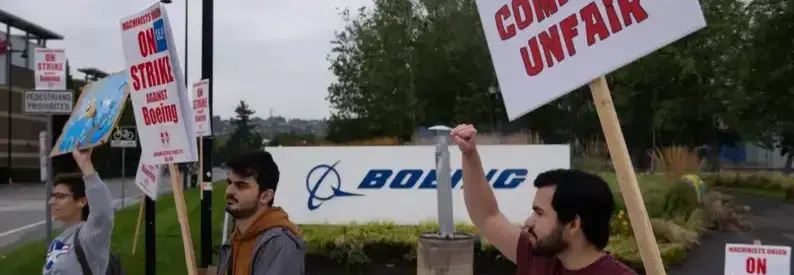Boeing Strike Impacts U.S. Jobs Report Before Election

The prolonged Boeing machinist strike, now over seven weeks in duration, is expected to weigh heavily on the final U.S. jobs report ahead of the November 5 presidential election and the upcoming Federal Reserve meeting. The Labor Department’s mid-October survey counted around 44,000 U.S. workers on strike, with approximately 33,000 of them being Boeing machinists. These workers walked off the job on September 13 following a vote rejecting a union-endorsed labor contract.
Economists predict that October’s employment growth will reflect a diminished figure due to the strike’s influence. Bank of America forecasts a reduction of at least 50,000 in payrolls, factoring in not only the Boeing strike but also the economic repercussions from Hurricanes Helene and Milton. Federal Reserve Governor Christopher Waller recently noted that these factors might contribute to a 100,000-job shortfall in the October report, describing it as a “significant but temporary” setback. While this reduction may minimally impact the unemployment rate, it is expected to capture attention as election day approaches.
The Boeing strike comes at a challenging time for the company as its new CEO, Kelly Ortberg, works to stabilize Boeing amidst ongoing safety, quality, and financial issues. Last week, a 64% majority of the machinists union in Seattle voted against Boeing’s latest contract offer, which proposed a 35% wage increase, up from the previously proposed 25% hike. The Biden administration has actively urged both parties to reach an agreement, with Acting Secretary of Labor Julie Su participating in negotiations.
Ortberg has indicated that Boeing will move forward with a workforce reduction of approximately 17,000 jobs, or 10% of its global workforce. This round of job cuts is expected to begin in mid-November as part of a strategy to streamline operations and cut overhead. Ortberg acknowledged employee feedback, stating that excessive overhead was hampering productivity. “We’ll focus this workforce reduction on consolidating roles and streamlining processes to improve efficiency,” he explained in an October 23 earnings call.
The Boeing strike’s impact extends beyond the company itself, affecting its supply chain, including Boeing fuselage supplier Spirit AeroSystems. Spirit recently announced a 21-day furlough for 700 workers at its Wichita, Kansas facility, with a spokesperson confirming that additional furloughs or layoffs are under consideration if the strike continues beyond November 25. This ripple effect through the aerospace sector underscores the broader economic consequences of the strike, which could further strain the fragile aerospace supply chain.
In addition to the strikes, the job cuts resulting from Boeing’s restructuring efforts are more difficult to measure in employment reports. Unlike strikes, layoffs often have unpredictable timing, as noted by Bank of America economist Stephen Juneau. With the aerospace sector still recovering from pandemic-related challenges, Boeing’s workforce reductions and the protracted strike may influence job numbers for months.
As Boeing and the union continue negotiations, the situation reflects ongoing challenges in U.S. manufacturing and the aerospace industry. The October jobs report will likely highlight the economic impact of labor disputes and corporate restructuring, underscoring the importance of stability in the aerospace supply chain as one of America’s largest exporters faces transformation under its new leadership.
Related News : https://suspicious-zhukovsky.67-21-117-18.plesk.page/?s=Boeing+strike
Sources: AirGuide Business airguide.info, bing.com, cnbc.com
